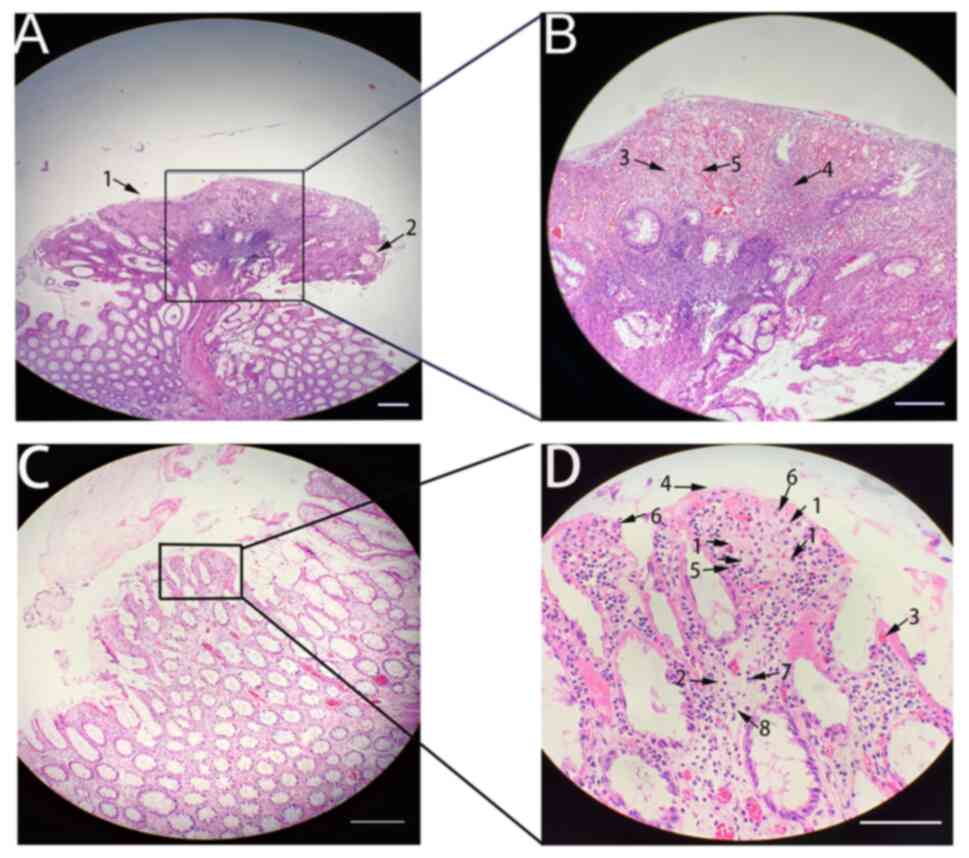|
1
|
Leonard NB and Bronner MP: Giant gastric
folds in juvenile polyposis. Case Rep Gastroenterol. 15:985–993.
2021.PubMed/NCBI View Article : Google Scholar
|
|
2
|
Brosens LA, van Hattem A, Hylind LM,
Iacobuzio-Donahue C, Romans KE, Axilbund J, Cruz-Correa M,
Tersmette AC, Offerhaus GJ and Giardiello FM: Risk of colorectal
cancer in juvenile polyposis. Gut. 56:965–967. 2007.PubMed/NCBI View Article : Google Scholar
|
|
3
|
Calva-Cerqueira D, Chinnathambi S, Pechman
B, Bair J, Larsen-Haidle J and Howe JR: The rate of germline
mutations and large deletions of SMAD4 and BMPR1A in juvenile
polyposis. Clin Genet. 75:79–85. 2009.PubMed/NCBI View Article : Google Scholar
|
|
4
|
Gao XH, Li J, Zhao ZY, Xu XD, Du YQ, Yan
HL, Liu LJ, Bai CG and Zhang W: Juvenile polyposis syndrome might
be misdiagnosed as familial adenomatous polyposis: A case report
and literature review. BMC Gastroenterol. 20(167)2020.PubMed/NCBI View Article : Google Scholar
|
|
5
|
Aretz S, Stienen D, Uhlhaas S, Stolte M,
Entius MM, Loff S, Back W, Kaufmann A, Keller KM, Blaas SH, et al:
High proportion of large genomic deletions and a genotype phenotype
update in 80 unrelated families with juvenile polyposis syndrome. J
Med Genet. 44:702–709. 2007.PubMed/NCBI View Article : Google Scholar
|
|
6
|
Latchford AR, Neale K, Phillips RK and
Clark SK: Juvenile polyposis syndrome: A study of genotype,
phenotype, and long-term outcome. Dis Colon Rectum. 55:1038–1043.
2012.PubMed/NCBI View Article : Google Scholar
|
|
7
|
Patel R and Hyer W: Practical management
of polyposis syndromes. Frontline Gastroenterol. 10:379–387.
2019.PubMed/NCBI View Article : Google Scholar
|
|
8
|
Gammon A, Jasperson K, Kohlmann W and Burt
RW: Hamartomatous polyposis syndromes. Best Pract Res Clin
Gastroenterol. 23:219–231. 2009.PubMed/NCBI View Article : Google Scholar
|
|
9
|
Liu S, Ma Y, You W, Li J, Li JN and Qian
JM: Hamartomatous polyposis syndrome associated malignancies: Risk,
pathogenesis and endoscopic surveillance. J Dig Dis. 22:444–451.
2021.PubMed/NCBI View Article : Google Scholar
|
|
10
|
Chen YW, Tu JF, Shen WJ, Chen WY and Dong
J: Diagnosis and management of a solitary colorectal juvenile polyp
in an adult during follow-up for ulcerative colitis: A case report.
World J Gastroenterol. 26:877–882. 2020.PubMed/NCBI View Article : Google Scholar
|
|
11
|
Zheng Z, Yin J, Li Z, Ye Y, Wei B, Wang X,
Tian Y, Li M, Zhang Q, Zeng N, et al: Protocol for expanded
indications of endoscopic submucosal dissection for early gastric
cancer in China: A multicenter, ambispective, observational,
open-cohort study. BMC Cancer. 20(801)2020.PubMed/NCBI View Article : Google Scholar
|
|
12
|
Zbuk KM and Eng C: Hamartomatous polyposis
syndromes. Nat Clin Pract Gastroenterol Hepatol. 4:492–502.
2007.PubMed/NCBI View Article : Google Scholar
|
|
13
|
Dickey W, Alderdice J and McConnell B:
Dysplastic change in the solitary juvenile polyp. Endoscopy.
28(641)1996.PubMed/NCBI View Article : Google Scholar
|
|
14
|
Jelsig AM, Ousager LB, Brusgaard K and
Qvist N: Juvenile polyps in Denmark from 1995 to 2014. Dis Colon
Rectum. 59:751–757. 2016.PubMed/NCBI View Article : Google Scholar
|
|
15
|
Chow E and Macrae F: A review of juvenile
polyposis syndrome. J Gastroenterol Hepatol. 20:1634–1640.
2005.PubMed/NCBI View Article : Google Scholar
|
|
16
|
Brosens LA, Langeveld D, Van Hattem WA,
Giardiello FM and Offerhaus GJ: Juvenile polyposis syndrome. World
J Gastroenterol. 17:4839–4844. 2011.PubMed/NCBI View Article : Google Scholar
|
|
17
|
Hirotani A, Sakai E, Nakajima A, Kawana K
and Nagase H: Endoscopic findings of atypical juvenile colonic
polyps. Gastrointest Endosc. 83:476–477. 2016.PubMed/NCBI View Article : Google Scholar
|
|
18
|
Chung EJ, Lee JY, Choe J, Chang HS, Kim J,
Yang DH, Ye BD, Byeon JS, Kim KJ, Yang SK, et al: Colonic chicken
skin mucosa is an independent endoscopic predictor of advanced
colorectal adenoma. Intest Res. 13:318–325. 2015.PubMed/NCBI View Article : Google Scholar
|
|
19
|
Adamiec C, Folwarski M, Dubowik M, Adrych
K, Kaźmierczak-Siedlecka K and Makarewicz W: Kudo's pit pattern
classification for in vivo optical diagnosis and discrimination of
advanced colorectal polyps. Eur Rev Med Pharmacol Sci.
26:2832–2839. 2022.PubMed/NCBI View Article : Google Scholar
|
|
20
|
Hijos-Mallada G, Velamazán R, Marti R,
Chueca E, Arechavaleta S, Lué A, Gomollón F, Lanas A and Sostres C:
A patient self-made point-of-care fecal test improves diagnostic
accuracy compared with fecal calprotectin alone in inflammatory
bowel disease patients. Diagnostics (Basel).
11(2323)2021.PubMed/NCBI View Article : Google Scholar
|
|
21
|
Hodgson-Parnell L, Spence O and Chapple K:
Solitary juvenile polyp as a cause of elevated faecal calprotectin
in an adult. BMJ Case Rep. 2018(bcr2018224770)2018.PubMed/NCBI View Article : Google Scholar
|











